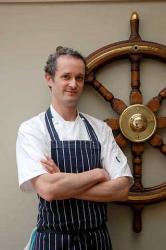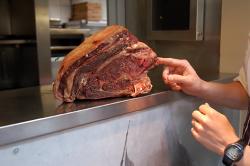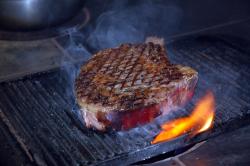 As a trainee chef some 40 years ago, I learned to cook steaks over hot coals. Head Chef Fred Smith looked at me in disbelief. I explained that I couldn’t remember any steaks coming back to the kitchen with complaints. ‘People didn’t complain much then,” Fred commented.
As a trainee chef some 40 years ago, I learned to cook steaks over hot coals. Head Chef Fred Smith looked at me in disbelief. I explained that I couldn’t remember any steaks coming back to the kitchen with complaints. ‘People didn’t complain much then,” Fred commented.
We moved on to take a look at the recent refurbishments. We made our way toward the restaurant at the rear of the pub to discover some nice booth seating and renovated kitchen area, which allows customers a view through the new pass to witness the activity going on behind it. Exposing the kitchen to the eye of the diner seems to be a popular design, and one that customers are likely to find enjoyable.
Fred and I talked about the menu and meat, particularly the Jack O’Shea beef. He explained that O’Shea supplies their Irish farm-raised, free range beef to him via their outlet in Selfridges Food Hall. Black Angus cattle are grain fed for 200 to 250 days before slaughter to produce better flavour and good marbling in the meat, which is essential for a good steak or beef joint. Fred told me that Heston Blumenthal also sources his beef from O’Shea, so he’s in good company there.
 Fred buys the beef when it has aged 14-21 days, so he can examine that each joint has a good amount of marbling. If he waited longer, the marbling would be camouflaged by the darkening of the aging meat. After purchasing a suitable cut, Fred continues to age the meat to the 28-35 day point in a dedicated meat refrigerator in the cellar. The dedicated equipment avoids mixing of other flavours which might affect its flavour.
Fred buys the beef when it has aged 14-21 days, so he can examine that each joint has a good amount of marbling. If he waited longer, the marbling would be camouflaged by the darkening of the aging meat. After purchasing a suitable cut, Fred continues to age the meat to the 28-35 day point in a dedicated meat refrigerator in the cellar. The dedicated equipment avoids mixing of other flavours which might affect its flavour.
Little meat goes to waste in the kitchen. Fred uses the fatty outer cut in a 50:50 ratio with chuck steak to make his own burgers. ‘The mix of the chuck steak and the fatty part of the Black Angus rib makes very juicy burgers,” Fred explained. Any additional fat is then trimmed off the joint and rendered for use in cooking, like Yorkshire puddings.
 With all of this attention to the quality of the meat, our conversation shifted back to discuss the best cooking method. Fred showed me his way. First, Fred heated a griddle pan until fiercely hot. He then seasoned a a double cut rib portion about 4cm thick with Maldon sea salt, and rubbed in the slightest drizzle of oil on one side to prevent sticking to the pan. Gentleness aside, he then plunked the hunk of meat onto the pan to sear all sides. The steak was finished off in the oven at 195 degrees for 12 minutes, with a knob of butter melted underneath and another on top. Once cooked, he left the meat to rest for about 8 minutes before presenting it on a board with a jug of the buttery cooking juices and some béarnaise sauce. My tastebuds are happy to report that the result was medium rare, divinely tender and full flavoured.
With all of this attention to the quality of the meat, our conversation shifted back to discuss the best cooking method. Fred showed me his way. First, Fred heated a griddle pan until fiercely hot. He then seasoned a a double cut rib portion about 4cm thick with Maldon sea salt, and rubbed in the slightest drizzle of oil on one side to prevent sticking to the pan. Gentleness aside, he then plunked the hunk of meat onto the pan to sear all sides. The steak was finished off in the oven at 195 degrees for 12 minutes, with a knob of butter melted underneath and another on top. Once cooked, he left the meat to rest for about 8 minutes before presenting it on a board with a jug of the buttery cooking juices and some béarnaise sauce. My tastebuds are happy to report that the result was medium rare, divinely tender and full flavoured.
While restaurants may have made some techniques more complicated over the past 40 years, Fred’s demonstration showed me that grilling meat has remained almost as straightforward as I remember it.
The Admiral Codrington, 17 Mossop Street, London SW3 2LY www.theadmiralcodrington.co.uk
